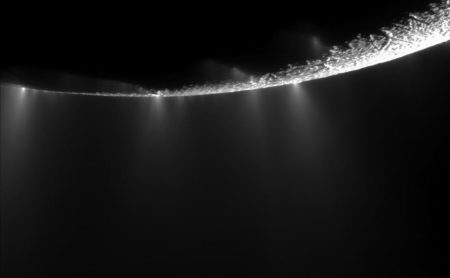October 3, 2019 – With both NASA and European Space Agency rovers scheduled for Mars in 2020, both with chemistry labs on board that will likely detect complex organics and potentially life, you would think the Red Planet would be a shoo-in to make first claim on extraterrestrial life. But Enceladus, a small Saturnian moon is giving Mars a run for its money.
The mission to Saturn may be over in terms of the spacecraft itself, but the data continues to reveal incredible findings more than two years after Cassini’s demise. Cassini had observed plumes of water shooting out into space from Enceladus on flybys. On one the spacecraft flew right through the plumes, sampling their contents.
What did they find?
Organic compounds were being shot into space originating from deep inside the moon. The compounds contained organic molecules composed partially of nitrogen and oxygen dissolved in the water plumes. The discovery is documented in the November 2019 issue of the journal of the Royal Astronomical Society, Monthly Notices.
In the article, it states “Enceladus is erupting a plume of gas and ice grains…linked directly to the moon’s subsurface global ocean.” The ejected material is believed to come from the bottom of the ocean where hydrothermal vents are suspected to exist similar to the black smokers observed deep in Earth’s oceans. The compositional analysis using Cassini’s onboard Ion and Neutral Mass Spectrometer “indicate low-mass organic compounds” including dimethylamine, carbonyls. It further states these “compounds could be ideal precursors for mineral-catalyzed….hydrothermal synthesis of biologically relevant organic compounds in the warm depths of Enceladus’ ocean.”
The idea that such a small icy moon in the outer Solar System could be geologically active was the first startling discovery Cassini made when it flew by Enceladus. But now we have evidence that it could be an inhabited world which makes what is being discovered at Enceladus even more exciting.
Enceladus is sixth in the size hierarchy of Saturn’s moons. About 500 kilometers (310 miles) in diameter, its surface is covered by what appears to be fresh ice interspersed by cracks. It is so white in appearance that it is one of the most highly reflective celestial bodies in the Solar System. With peak surface temperature of −198 Celsius (-324 Fahrenheit), it is hard to imagine anything could be alive on or below its surface. But as Cassini unraveled its secrets, through repeated flybys, evidence of a subsurface ocean became abundant. Then came the visual evidence of water plumes erupting from cracks in the surface near the south pole where an ocean of water 10 kilometers (6 miles) deep was discovered. The plumes erupting from this ocean of water were warmer than Enceladus’ surface suggesting a geothermal energy source.
What that source turned out to be explains why Enceladus isn’t cold and dead. Tidal forces are pushing and pulling on the moon as it circles Saturn. These forces are further amplified by Enceladus’ neighbour, the moon Dione, in orbit close enough to exert an additional tidal pull on the moon’s surface. That’s why Enceladus is not just geologically active, but potentially biologically active as well.
States Nozair Khawaja, leader of the research team which published the article, “If the conditions are right, these molecules coming from the deep ocean of Enceladus could be on the same reaction pathway as we see here on Earth. We don’t yet know if amino acids are needed for life beyond Earth, but finding the molecules that form amino acids is an important piece of the puzzle.”










[…] presence of sulphur in LUCA has profound implications in the search for life other than on Earth. Mars, Enceladus (a moon of Saturn) and Europa (a moon of Jupiter) have significant amounts of sulphur compounds which means that when looking for biosignatures on […]